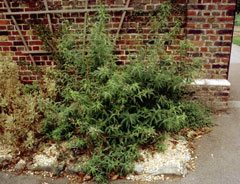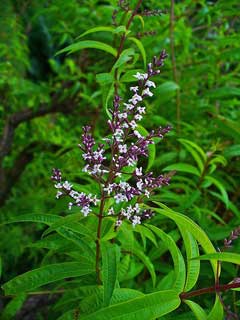 |
|
(c) 2010 Ken Fern, Plants For A Future |
 |
|
Translate this page:
Summary
UPDATE 20/09/2011: Aloysia triphylla (L'Hér.) Britton is a synonym of Aloysia citriodora Palau. Lemon verbena is a perennial shrub native to South America. It was brought to Europe by the Spanish and the Portuguese in the 17th century and cultivated for its oil. The plant has long been used for its citrusy scent and flavour and has many uses in herbalism and cooking. Lemon verbena is high in citral, which gives the plant its characteristic lemon smell. The delicious lemon-like leaves are used to flavour salads and fruit salads. The leaves can be cooked as spinach. Make a delightful and refreshing tea from the leaves. The dried leaves will retain their lemon aroma for many years. The leaves make an essential oil used in perfumery and an effective insecticide in 1-2% concentration. The root pattern is rhizomatous. Leaves are available all year. Pick leaves once the plant is established.
Harvesting: Leaves throughout the growing season, but they are best picked just before or during flowering, typically in late spring to summer.
Physical Characteristics

 Aloysia triphylla is a deciduous Shrub growing to 3 m (9ft) by 3 m (9ft) at a medium rate.
Aloysia triphylla is a deciduous Shrub growing to 3 m (9ft) by 3 m (9ft) at a medium rate.
See above for USDA hardiness. It is hardy to UK zone 8 and is frost tender. It is in leaf from May to November, in flower in August, and the seeds ripen from September to October. The species is hermaphrodite (has both male and female organs) and is pollinated by Insects. The plant is self-fertile.
Suitable for: light (sandy) and medium (loamy) soils and prefers well-drained soil. Suitable pH: mildly acid, neutral and basic (mildly alkaline) soils. It can grow in semi-shade (light woodland) or no shade. It prefers dry or moist soil.
UK Hardiness Map
US Hardiness Map
Synonyms
Aloysia triphylla (L'Hér.)Britton. A. triphylla. Lippia citrodora. L. triphylla. Verbena triphylla.
Plant Habitats
Woodland Garden Sunny Edge; South Wall. By. West Wall. By.
Edible Uses
Edible Parts: Leaves
Edible Uses: Condiment Tea
Leaves - occasionally cooked as a spinach[177] but more commonly used as a flavouring in salads, fruit salads etc[14, 21, 104, 183]. A delicious lemon-like flavour, it is adored by most people who try it[K]. A delicious and refreshing tea is made from the leaves[14, 21, 103, 183]. The dried leaves will retain their lemon aroma for many years[4].
References More on Edible Uses
Medicinal Uses
Plants For A Future can not take any responsibility for any adverse effects from the use of plants. Always seek advice from a professional before using a plant medicinally.
Antispasmodic Aromatherapy Febrifuge Sedative Stomachic
An undervalued medicinal herb, lemon verbena contains a strong lemon-scented essential oil that has calming and digestive qualities[254]. The plant has a gentle sedative action and a reputation for soothing abdominal discomfort. It has a mildly tonic effect upon the nervous system and helps to lift the spirits and counter depression[254]. The leaves and the flowering tops are antispasmodic, febrifuge, sedative and stomachic[4, 7, 238, 240]. A tea made from the leaves has a deliciously refreshing lemon flavour and is used mainly in treating digestive disorders[4] such as flatulence, indigestion and acidity[244]. Some caution is advisable though, since prolonged use or large internal doses can cause gastric irritation[268]. The herb is also useful as a stimulant for treating lethargy or depression[244] whilst it is also used to treat feverish colds[238]. The essential oil is used in aromatherapy in the treatment of nervous and digestive problems and also for acne, boils and cysts[238].
References More on Medicinal Uses
The Bookshop: Edible Plant Books
Our Latest books on Perennial Plants For Food Forests and Permaculture Gardens in paperback or digital formats.

Edible Tropical Plants
Food Forest Plants for Hotter Conditions: 250+ Plants For Tropical Food Forests & Permaculture Gardens.
More

Edible Temperate Plants
Plants for Your Food Forest: 500 Plants for Temperate Food Forests & Permaculture Gardens.
More

More Books
PFAF have eight books available in paperback and digital formats. Browse the shop for more information.
Shop Now
Other Uses
Essential Insecticide Pot-pourri Repellent
Lemon verbena can be used as a companion plant to attract pollinators and beneficial insects. Its strong fragrance can help repel certain pests, making it beneficial in organic gardens. An essential oil obtained from the leaves is extensively used in perfumery[7, 61]. An average yield of 0.5% is obtained[7]. There is some evidence that the use of this oil can sensitise the skin to sunlight and so its use has been largely replaced by the tropical plant lemongrass, Cymbopogon spp.[238]. The dried leaves retain their fragrance well and so are used in pot-pourri[238]. The growing plant repels midges, flies and other insects[201]. The essential oil is an effective insecticide in 1 - 2% concentration[240]. Landscape: Flower borders and beds Wall-side Borders City & Courtyard Gardens Cottage & Informal Garden Mediterranean Climate Plants. 1. Nectary - Flowers rich in nectar and pollen: Yes – Lemon verbena flowers produce nectar and attract pollinators like bees and butterflies. However, they are not as heavily visited as other highly nectar-rich plants. 2. Wildlife - Food (Fruit, Seeds, Leaf litter, Shelter, Nesting, Roosting):
No – Wildlife does not typically use Lemon verbena for food or shelter. It doesn’t produce significant fruit or seeds for consumption by birds or animals, and its foliage is not dense enough to offer substantial shelter for nesting or roosting. 3. Invertebrate Shelter (Overwintering sites, Leaf litter, Groundcover):
No – While the plant does shed leaves, it is not typically dense enough to provide invertebrates with extensive shelter or overwintering sites. 4. Pest Confuser (Smell): Yes – Lemon verbena has a strong lemon fragrance, which can act as a natural deterrent for pests like mosquitoes and some insects, making it useful in pest management.
Special Uses
Scented Plants
References More on Other Uses
Cultivation details
Succeeds in most moderately fertile soils if they are well-drained[200]. Prefers a light soil[219]. Requires a sunny sheltered position[166, 200]. Requires a warm damp climate[7]. A very ornamental plant[1], lemon verbena is only hardy in the milder areas of Britain[1, 11, 14], growing well in Cornwall[59]. It can withstand about 10°c of frost[184] and survives outdoors on a wall at Kew[K]. It generally survives most winters outdoors if growing in a suitable position, though it is often cut back to ground level and then resprouts from the base in late spring[120] or early summer[238]. Giving the roots a good, thick organic mulch will confer extra protection from winter cold[244]. The plant succeeds outdoors at Howick, a garden on the coast of Northumberland. The leaves are very aromatic with a lemon scent[182], they are often used to make a drink or for their essential oils[4]. There has been considerable confusion over the naming of this species. We are following the treatment used in [11] and [200], which is also the current treatment in the 1999 edition of The Plant Finder. However, the book 'World Economic Plants' uses the name A. citrodora Palau (a different author to the one we cite) as the correct name. Any pruning is best carried out in the spring[219]. This species is notably resistant to honey fungus[200]. In garden design, as well as the above-ground architecture of a plant, root structure considerations help in choosing plants that work together for their optimal soil requirements including nutrients and water. The root pattern is rhizomatous with underground stems sending roots and shoots along their length [2-1]. The leaves of lemon verbena can be harvested throughout the growing season, but they are best picked just before or during flowering, typically in late spring to summer. Lemon verbena flowers in summer, producing small, white to pale purple flowers. Lemon verbena is a fast-growing perennial shrub, typically reaching 3 to 6 feet (1 to 2 meters) in optimal conditions within one growing season.
References Carbon Farming Information and Carbon Sequestration Information
Temperature Converter
Type a value in the Celsius field to convert the value to Fahrenheit:
Fahrenheit:
The PFAF Bookshop
Plants For A Future have a number of books available in paperback and digital form. Book titles include Edible Plants, Edible Perennials, Edible Trees,Edible Shrubs, Woodland Gardening, and Temperate Food Forest Plants. Our new book is Food Forest Plants For Hotter Conditions (Tropical and Sub-Tropical).
Shop Now
Plant Propagation
Seed - we have no information for this species but suggest sowing the seed in a greenhouse in late spring. Only just cover the seed and keep in a light position, making sure the compost does not dry out. When large enough to handle, prick the seedlings out into individual pots and grow them on in the greenhouse for at least their first winter. Plant them out in early summer and give some protection from the cold for at least their first winter outdoors. Cuttings of softwood, May/June in a frame. Grow on for at least their first winter in a greenhouse and plant out in late spring after the last expected frosts[K]. The cuttings root quickly and easily, though there can be losses in the first winter[K]. Cuttings of half-ripe wood, August in a frame. Grow on for at least their first winter in a greenhouse and plant out in late spring after the last expected frosts[K]. The cuttings root quickly and easily, though there can be losses in the first winter[K].
Other Names
If available other names are mentioned here
Erba luigia, Lemon-verbena, Wapine [1-4]. Also known as: Aloysia citrodora, Cedrón, Herb Louisa, Hierba Luisa, Lemon-Scented Verbena, Lippia citrodora, Lippia triphylla, Louisa, Verbena Citrodora, Verbena triphylla, Verveine Citronnée, Verveine Citronnelle, Verveine des Indes, Verveine du Chili, Verveine du Pérou, Verveine Odorante, Zappania citrodora.
Native Range
SOUTHERN AMERICA: Argentina, Paraguay, Brazil, Uruguay, Chile, Bolivia, Peru,
Weed Potential
Right plant wrong place. We are currently updating this section.
Please note that a plant may be invasive in one area but may not in your area so it's worth checking.
Conservation Status
IUCN Red List of Threatened Plants Status :

Growth: S = slow M = medium F = fast. Soil: L = light (sandy) M = medium H = heavy (clay). pH: A = acid N = neutral B = basic (alkaline). Shade: F = full shade S = semi-shade N = no shade. Moisture: D = dry M = Moist We = wet Wa = water.
Now available:
Food Forest Plants for Mediterranean Conditions
350+ Perennial Plants For Mediterranean and Drier Food Forests and Permaculture Gardens.
[Paperback and eBook]
This is the third in Plants For A Future's series of plant guides for food forests tailored to
specific climate zones. Following volumes on temperate and tropical ecosystems, this book focuses
on species suited to Mediterranean conditions—regions with hot, dry summers and cool, wet winters,
often facing the added challenge of climate change.
Read More
Expert comment
Author
Palau
Botanical References
11200
Links / References
For a list of references used on this page please go here
Readers comment